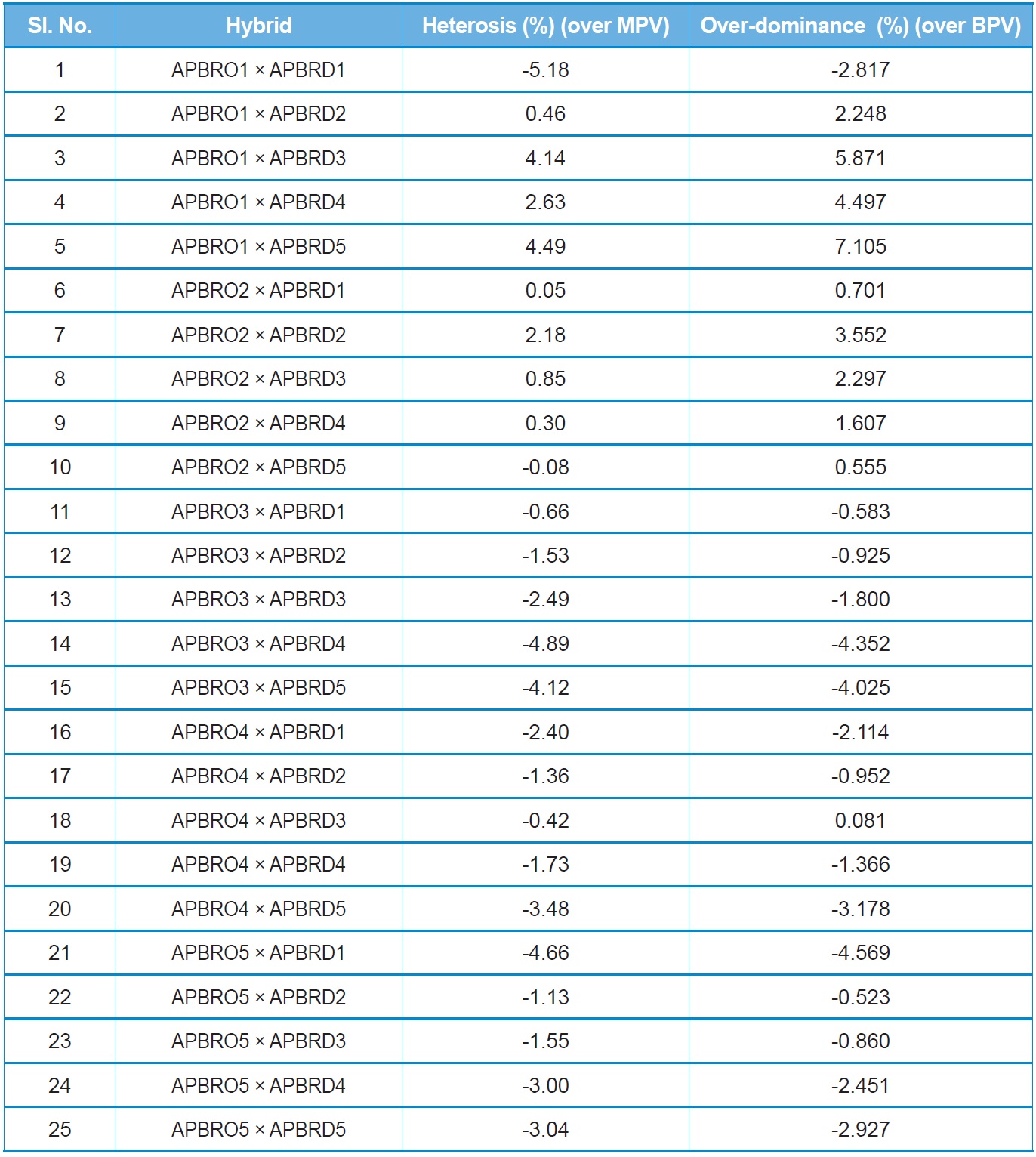



To face the global competitiveness in silk production there is a need to improve the quality of the raw silk and as such the sericulture industry requires good quality of silk to produce internationally gradable silk fabric to meet the requirement of the consumers across the world resulting in increased foreign exchange. To meet the specific requirement of the silk industry, the silkworm breeders have developed various hybrids such as productive breeds, robust breeds, breeds with special traits and sex limited races etc. Keeping this in view, most of the silkworm breeders have been concentrating on boil-off loss ratio to produce good quality silk as the boil-off loss ratio is one of the most important qualitative trait in silkworm breeding. The silkworm
The main silk substance fibroin is insoluble in alkaline hot water, whereas the sericin (silk gum) is easily soluble in boiling alkaline soap solution (Sadov
The loss of sericin varies in different races and also there is difference in the effect of sericin loss from raw silk on weaving and other post weaving process due to degumming (Sinha
Five oval breeds
The liquor solution of the soap and soda was boiled in a copper vessel. When the boiling media solution reached the boiling point (>90℃), the cocoon shell sample bags were immersed completely in boiling media kept tightly closed for 40 minutes. At an interval of 10 minutes, the sample bags were turned up and down for uniform and effective degumming.
In another container, the boiling media of the required concentration was prepared and kept ready at boiling point (>90℃), to transfer the sample material after the first boiling. Immediately after 40 minutes of the first boiling, the sample bags were removed and squeezed to remove the excess liquor solution and transferred to the second bath. The degumming was carried out for another 40 minutes similar to the first degumming as explained above.
Immediately after the second boiling, the sample bags with the degummed shells were rinsed for a minute in an already prepared boiling alkaline solution of 0.1 % sodium carbonate.
After rinsing in 0.1 % sodium carbonate solution, the sample bags with cocoon shells were washed thoroughly (for 15 minutes) in running water using a washing machine. Then, they were dried in the washing machine itself for 5 minutes to remove the excess moisture.
The degummed cocoon shells were transferred to perforated paper envelops and kept for drying in the oven at 105℃ for 5 hours. The dried sample packets were transferred to the desiccator for half an hour for absorption of excess moisture before recording the dry weight of the degummed silk.
The boil-off loss ratio percentage was calculated by using the formula:
The heterosis and heterobeltiosis were calculated by using the following formulae:
Heterobeltiosis (over-dominance) over better parental value
Multiple Trait Evaluation Index (Mano
Where,
A = Value obtained for a particular trait of a particular hybrid combination
B = Mean value of the particular trait of all the
[Table 1.] Mean performance of ten parental breeds
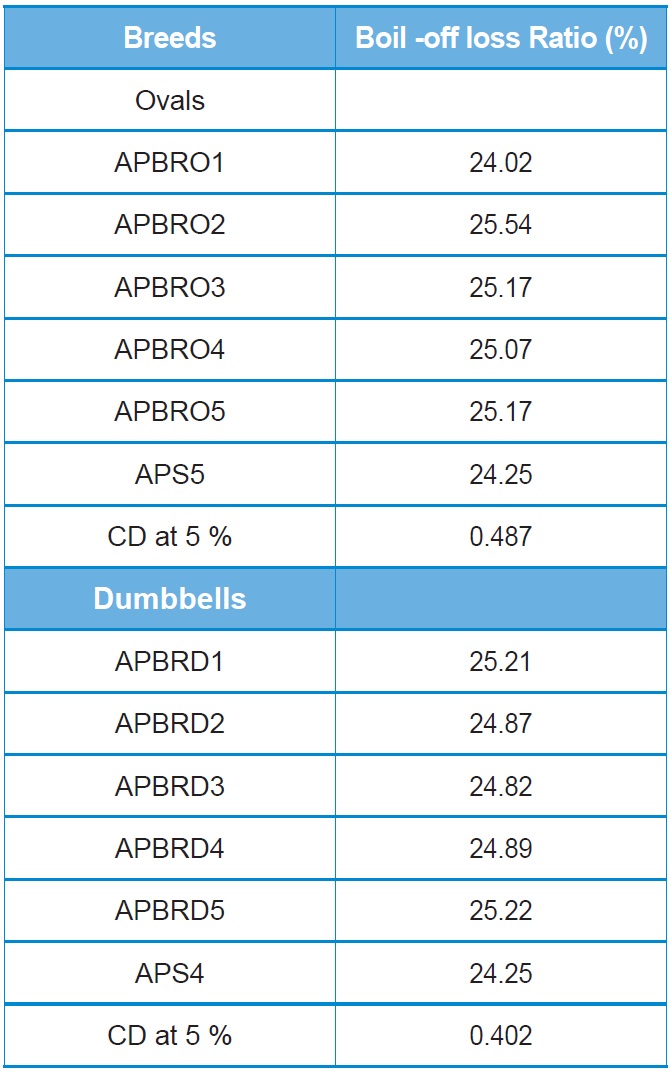
Mean performance of ten parental breeds
hybrid combinations
C = Standard deviation
10 = Standard unit and
50 = Fixed value
The boil-off loss ratio for the oval lines ranges from 24.02 % to 25.54 %. The variation in boil-off loss ratio among oval lines was less. Among oval lines the low boil-off loss ratio was recorded in APBRO1 (24.02 %) and maximum in APBRO2 (25.54 %). The average boil-off loss ratio of oval lines was 24.99% (Table 1). However, the entire oval breeds shown
[Table 2.] Mean Boil-off loss ratio of twenty five hybrids
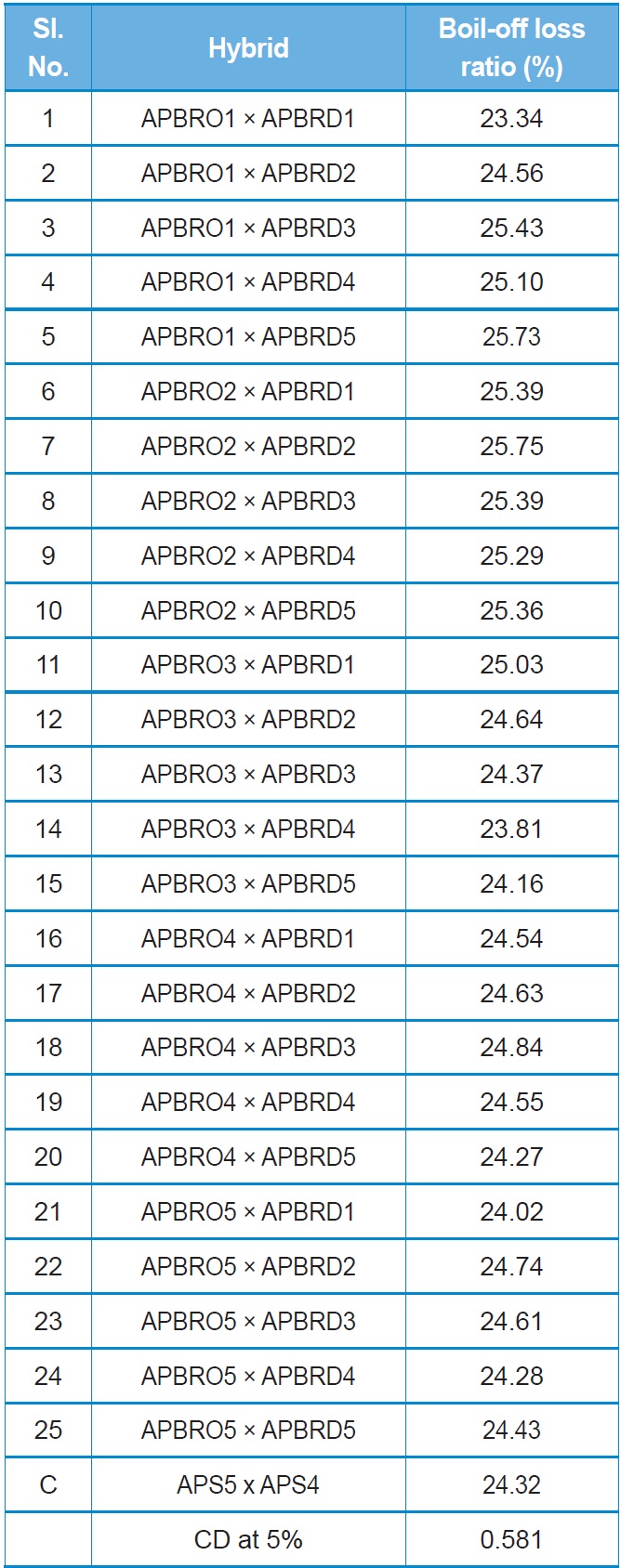
Mean Boil-off loss ratio of twenty five hybrids
slight variation among them.
Among dumbbell lines the low boil-off loss ratio was recorded in APBRD3 (24.82%) followed by and maximum boil-off loss ratio was recorded in APBRD5 (25.22%). The average boil-off loss ratio of dumbbell lines was 25.00%.
In case of hybrids the minimum boil-off loss ratio was recorded in APBRO1 × APBRD1 (23.34%) and maximum was recorded in APBRO2 × APBRD2 (25.75%) as against 24.32% in the control hybrid APS5 × APS4 (Table 2). Among the hybrid combinations, with regard to heterosis over MPV maximum negative heterosis was recorded in APBRO1 x APBRD1 (-5.18) followed by APBRO3 x APBRD4 (-4.89), APBRO5 x APBRD1 (-4.66) and APBRO3 x APBRD5 (-4.12) where as minimum was in APBRO2 x APBRD5 (-0.08). With regard to heterosis over BPV, maximum negative heterosis was recorded in APBRO5 x APBRD1 (-4.57) followed by APBRO3 x APBRD4 (-4.35), APBRO3 x APBRD5 (-4.03), APBRO4 x APBRD5 (-3.18) and APBRO5 x APBRD5 (-2.93) where as minimum was in APBRO5 x APBRD2 (-0.52). However, eight hybrid combinations have recorded positive boil-off loss ratio over MPV and ten hybrid combinations over BPV which is not desirable for the industry (Table 3). All the hybrid combinations that are involved with the female component of APBRO3, APBRO5 and APBRO4 are showing negative heterosis and heterobeltiosis for the boil-off loss ratio. The performance of these lines regarding boil-off loss ratio is more as pure lines and as a hybrid it is less when compared to the other hybrid combinations which clearly indicates that, these are best combiners regarding the negative heterosis towards this trait. The superiority of the hybrids over parental strains is undoubtedly due to variable magnitude of heterosis for the quantitative and qualitative characters in silkworm and the results of present study are corroborating the findings of Osawa and Harada (1944), Katsumata (1948) and Yokoyama (1962). It has been pointed out by Toyama (1906) that the F1 hybrids in silkworm,
[Table 3.] Heterosis and Over-dominance for Boil-off loss ratio in hybrids

Heterosis and Over-dominance for Boil-off loss ratio in hybrids
the present results are in support with the findings of Yokoyama (1979) and Singh & Hirobe (1964).
Low boil-off loss ratio improves reeling qualities and it is manifested by dominant genes, while recessive genes act in the opposite direction (Gamo and Hirabayashi, 1984). In sericulturally advanced
[Table 4.] Performance of the silkworm hybrids
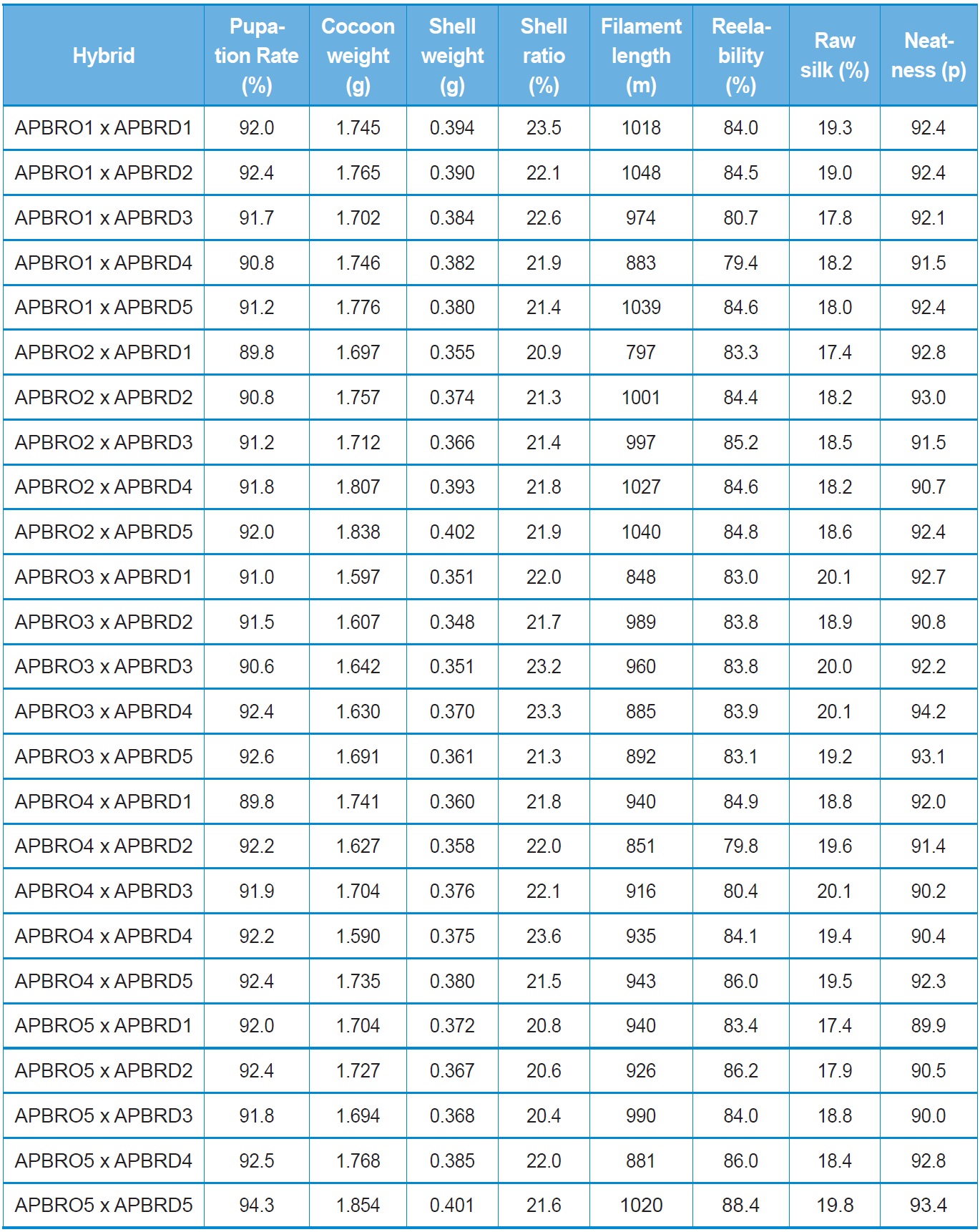
Performance of the silkworm hybrids
[Table 5.] Evaluation Index values of silkworm hybrids for each of the trait
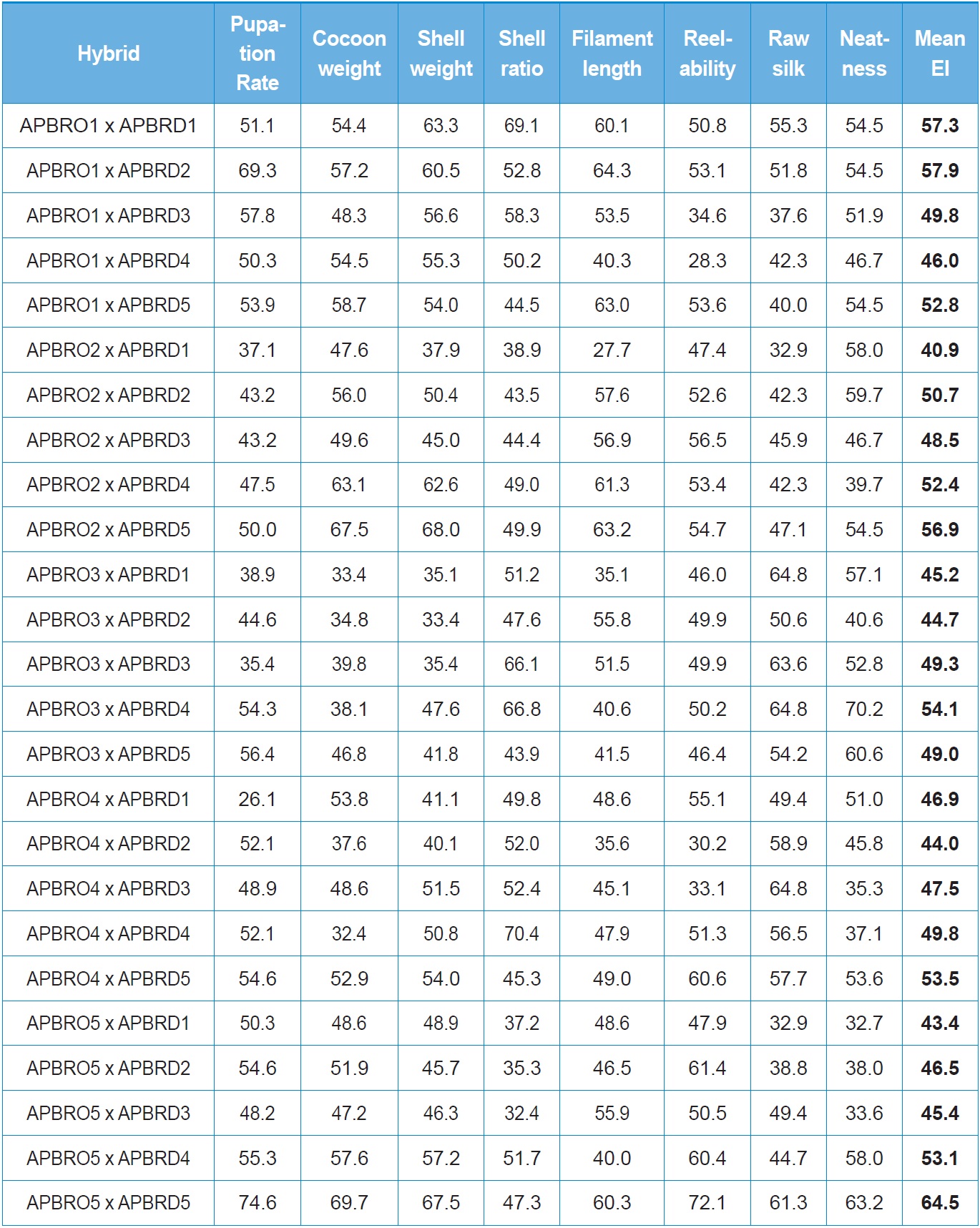
Evaluation Index values of silkworm hybrids for each of the trait
countries, the silkworm breeders have developed productive breeds / hybrids with low boil of ratio and quality silk (Gamo and Hirabayashi, 1983; Kurasawa, 1968). During the course of breeding, the boil off loss ratio with reference to cocoon shell has been given utmost importance along with other quantitative and qualitative traits (Gamo and Ichiba (1971); Harada, 1961; Mano
The phenomenon of heterosis and overdominance in conjunction with the expression of boil-off loss ratio analysed in the hybrids under present study facilitated procedures to identify the promising hybrids. Further, the more uniformity in the expression of this trait in hybrids than the parents is one of the desirable features to understand the genetic constitution of the hybrids for their commercial exploitation as evidenced by the mean values computed for boil-off loss ratio. For this trait, negative heterosis is desirable. For instance, high magnitude of negative heterosis was recorded in the combinations of APBRO5 x APBRD5, APBRO1 x APBRD1 and APBRO3 x APBRD4 which could be attributed to the higher mid parental values. The heterosis expressed is variable in different hybrids and these results are in confirmation with the findings of Gamo and Hirabayashi (1983). In certain hybrids, remarkably less heterosis was noticed and very often the hybrids were intermediate between parents for this trait. The result of the present study indicated the manifestation of heterosis in different hybrid combinations for this trait. Positive correlation that existed between boil- off loss ratio and cocoon shell weight of parental breeds clearly confirms the earlier findings of Gamo and Hirabayashi (1983). Improvement of boil-off loss ratio towards low value can be achieved through selection by choosing the crossing types showing higher negative heterosis for this trait. Based on the hybrids performance, boil-off loss ratio, heterosis and heterobeltiosis and evaluation index, the hybrids APBRO5 x APBRD5 followed by APBRO1 x APBRD1, APBRO3 x APBRD4 were identified for further commercial exploitation.


